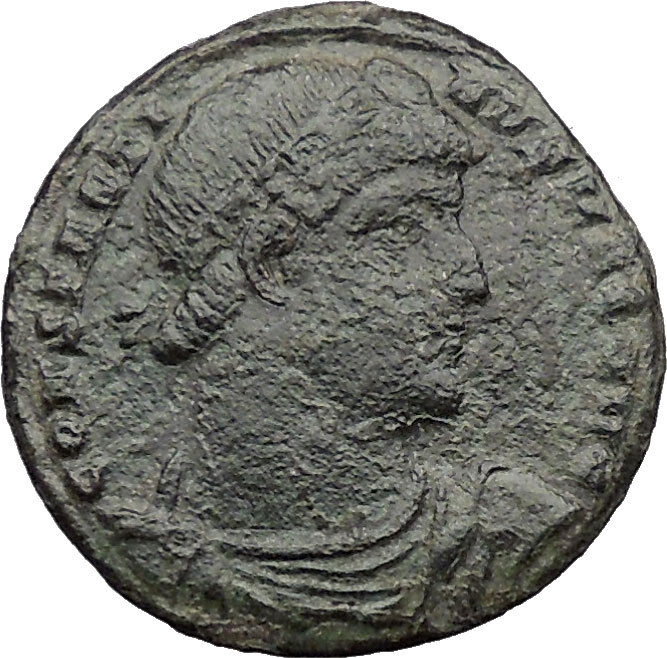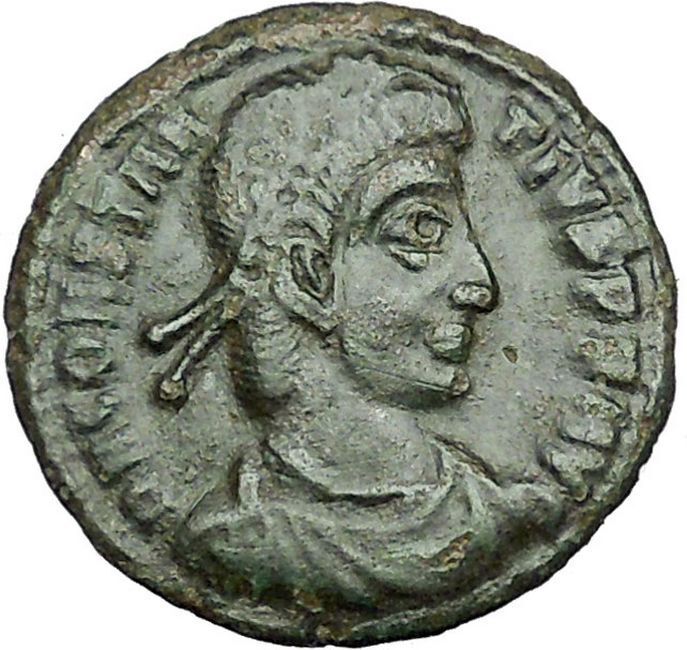|
Maximinus II ‘Daia’ – Roman Emperor: 308-313 A.D.
Bronze Follis 22mm (7.6 grams) Antioch mint, struck 305-306 A.D.
Reference: RIC VI 154
IMP C GAL VAL MAXIMINVS P F AVG, laureate head right.
SOLE INVICTO / (crescent)/Δ/ANT, Sol, radiate, standing left in long robe, right hand raised, head of Serapis in left hand.
You are bidding on the exact item pictured, provided with a Certificate of Authenticity and Lifetime Guarantee of Authenticity.
Sol was the solar deity in Ancient Roman religion. It was long thought that Rome actually had two different, consecutive sun gods. The first, Sol Indiges, was thought to have been unimportant, disappearing altogether at an early period. Only in the late Roman Empire, scholars argued, did solar cult re-appear with the arrival in Rome of the Syrian Sol Invictus, perhaps under the influence of the Mithraic mysteries. Recent publications have challenged the notion of two different sun gods in Rome, pointing to the abundant evidence for the continuity of the cult of Sol, and the lack of any clear differentiation – either in name or depiction – between the “early” and “late” Roman sun god.
 Maximinus II (Latin: Gaius Valerius Galerius Maximinus Daia Augustus; 20 November c. 270 – July or August 313), also known as Maximinus Daia or Maximinus Daza, was Roman Emperor from 308 to 313. He became embroiled in the Civil wars of the Tetrarchy between rival claimants for control of the empire, in which he was defeated by Licinius. A committed pagan, he engaged in one of the last persecutions of Christians. Maximinus II (Latin: Gaius Valerius Galerius Maximinus Daia Augustus; 20 November c. 270 – July or August 313), also known as Maximinus Daia or Maximinus Daza, was Roman Emperor from 308 to 313. He became embroiled in the Civil wars of the Tetrarchy between rival claimants for control of the empire, in which he was defeated by Licinius. A committed pagan, he engaged in one of the last persecutions of Christians.
Early career
He was born of Dacian peasant stock to the sister of the emperor Galerius near their family lands around Felix Romuliana, a rural area then in the Danubian region of Moesia, now Eastern Serbia.
He rose to high distinction after joining the army.
In 305, his maternal uncle Galerius became the eastern Augustus and adopted Maximinus, raising him to the rank of caesar (in effect, the junior eastern Emperor), and granting him the government of Syria and Egypt.
Civil war
In 308, after the elevation of Licinius to Augustus, Maximinus and Constantine were declared filii Augustorum (“sons of the Augusti”), but Maximinus probably started styling himself after Augustus during a campaign against the Sassanids in 310. On the death of Galerius in 311, Maximinus divided the Eastern Empire between Licinius and himself. When Licinius and Constantine began to make common cause, Maximinus entered into a secret alliance with the usurper Caesar Maxentius, who controlled Italy. He came to an open rupture with Licinius in 313; he summoned an army of 70,000 men but sustained a crushing defeat at the Battle of Tzirallum in the neighbourhood of Heraclea Perinthus on April 30. He fled, first to Nicomedia and afterwards to Tarsus, where he died the following August. His death was variously ascribed “to despair, to poison, and to the divine justice”.
Persecution of Christians
Maximinus has a bad name in Christian annals for renewing their persecution after the publication of the Edict of Toleration by Galerius, acting in response to the demands of various urban authorities asking to expel Christians. In one rescript replying to a petition made by the inhabitants of Tyre, transcribed by Eusebius of Caesarea, Maximinus expounds an unusual pagan orthodoxy, explaining that it is through “the kindly care of the gods” that one could hope for good crops, health, and the peaceful sea, and that not being the case, one should blame “the destructive error of the empty vanity of those impious men [that] weighed down the whole world with shame”. In one extant inscription (CIL III.12132, from Arycanda) from the cities of Lycia and Pamphylia asking for the interdiction of the Christians, Maximinus replied, in another inscription, by expressing his hope that “may those […] who, after being freed from […] those by-ways […] rejoice [as] snatched from a grave illness”.
After the victory of Constantine over Maxentius, however, Maximinus wrote to the Praetorian Prefect Sabinus that it was better to “recall our provincials to the worship of the gods rather by exhortations and flatteries”. Eventually, on the eve of his clash with Licinius, he accepted Galerius’ edict; after being defeated by Licinius, shortly before his death at Tarsus, he issued an edict of tolerance on his own, granting Christians the rights of assembling, of building churches, and the restoration of their confiscated properties.
Eusebius on Maximinus
The Christian writer Eusebius claims that Maximinus was consumed by avarice and superstition. He also allegedly lived a highly dissolute lifestyle:
And he went to such an excess of folly and drunkenness that his mind was deranged and crazed in his carousals; and he gave commands when intoxicated of which he repented afterward when sober. He suffered no one to surpass him in debauchery and profligacy, but made himself an instructor in wickedness to those about him, both rulers and subjects. He urged on the army to live wantonly in every kind of revelry and intemperance, and encouraged the governors and generals to abuse their subjects with rapacity and covetousness, almost as if they were rulers with him.
Why need we relate the licentious, shameless deeds of the man, or enumerate the multitude with whom he committed adultery? For he could not pass through a city without continually corrupting women and ravishing virgins.
According to Eusebius, only Christians resisted him.
For the men endured fire and sword and crucifixion and wild beasts and the depths of the sea, and cutting off of limbs, and burnings, and pricking and digging out of eyes, and mutilations of the entire body, and besides these, hunger and mines and bonds. In all they showed patience in behalf of religion rather than transfer to idols the reverence due to God.
And the women were not less manly than the men in behalf of the teaching of the Divine Word, as they endured conflicts with the men, and bore away equal prizes of virtue. And when they were dragged away for corrupt purposes, they surrendered their lives to death rather than their bodies to impurity.
He refers to one high-born Christian woman who rejected his advances. He exiled her and seized all of her wealth and assets. Eusebius does not give the girl a name, but Tyrannius Rufinus calls her “Dorothea,” and writes that she fled to Arabia. This story may have evolved into the legend of Dorothea of Alexandria. Caesar Baronius identified the girl in Eusebius’ account with Catherine of Alexandria, but the Bollandists rejected this theory.
See also
- Civil Wars of the Tetrarchy (306-324 AD)
|





 Maximinus II (Latin: Gaius Valerius Galerius Maximinus Daia Augustus; 20 November c. 270 – July or August 313), also known as Maximinus Daia or Maximinus Daza, was Roman Emperor from 308 to 313. He became embroiled in the Civil wars of the Tetrarchy between rival claimants for control of the empire, in which he was defeated by Licinius. A committed pagan, he engaged in one of the last persecutions of Christians.
Maximinus II (Latin: Gaius Valerius Galerius Maximinus Daia Augustus; 20 November c. 270 – July or August 313), also known as Maximinus Daia or Maximinus Daza, was Roman Emperor from 308 to 313. He became embroiled in the Civil wars of the Tetrarchy between rival claimants for control of the empire, in which he was defeated by Licinius. A committed pagan, he engaged in one of the last persecutions of Christians.




